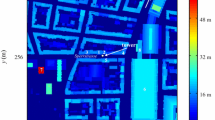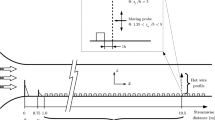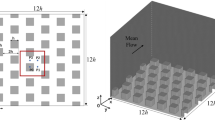Abstract
We describe and explain the turbulent processes at play in the lower part of the urban boundary layer through performing a large-eddy simulation of the flow over an urban-like canopy composed of a staggered array of cubes with a packing density of 25%. The simulation models neutral thermal conditions at a Reynolds number (based on both velocity at the top of the domain and the domain height) of \(Re = 50{,}000\). A dynamic Smagorinsky model is implemented in order to allow for energy backscattering from subgrid scales. A wall refinement of the grid allows resolving the viscous sublayer. Turbulent statistics up to the third order, as well as each term of the turbulence-kinetic-energy budget, are computed individually everywhere in the domain. Results are discussed in relation to experimental and numerical data from the literature in order to describe turbulent energy transfers occurring in the roughness sublayer. The fine grid resolution close to surfaces serves to analyze in depth the three-dimensional distribution of turbulence production inside the urban canopy layer. This analysis in turn leads to discovering areas, never previously documented in an urban-like canopy, of highly positive and highly negative production close to the surface, away from the well-known high production area in the shear layer. Furthermore, evidence of a close link between high and low production areas near the surfaces and singular points in the mean flow is presented, thus laying the groundwork for a simple pre-diagnostic tool to detect turbulence-kinetic-energy production areas near surfaces.











Similar content being viewed by others
References
Adrian RJ (2007) Hairpin vortex organization in wall turbulence. Phys Fluids 19(4):041,301
Blackman K, Perret L (2016) Non-linear interactions in a boundary layer developing over an array of cubes using stochastic estimation. Phys Fluids 28(9):095,108
Blackman K, Perret L, Calmet I, Rivet C (2017) Turbulent kinetic energy budget in the boundary layer developing over an urban-like rough wall using PIV. Phys Fluids 29(8):085,113
Boppana VBL, Xie ZT, Castro IP (2010) Large-Eddy simulation of dispersion from surface sources in arrays of obstacles. Boundary-Layer Meteorol 135(3):433–454
Bou-Zeid E, Overney J, Rogers BD, Parlange MB (2009) The effects of building representation and clustering in large-eddy simulations of flows in urban canopies. Boundary-Layer Meteorol 132(3):415–436
Brooke JW, Hanratty T (1993) Origin of turbulence-producing eddies in a channel flow. Phys Fluids 5(4):1011–1022
Calmet I, Magnaudet J (1997) Large-eddy simulation of high-Schmidt number mass transfer in a turbulent channel flow. Phys Fluids 9(2):438–455
Castro IP, Cheng H, Reynolds R (2006) Turbulence over urban-type roughness: deductions from wind-tunnel measurements. Boundary-Layer Meteorol 118(1):109–131
Castro IP, Xie ZT, Fuka V, Robins AG, Carpentieri M, Hayden P, Hertwig D, Coceal O (2017) Measurements and computations of flow in an urban street system. Boundary-Layer Meteorol 162(2):207–230
Cheng H, Castro IP (2002) Near wall flow over urban-like roughness. Boundary-Layer Meteorol 104(2):229–259
Cheng H, Hayden P, Robins A, Castro I (2007) Flow over cube arrays of different packing densities. J Wind Eng Ind Aerodyn 95(8):715–740
Christen A, Rotach MW, Vogt R (2009) The budget of turbulent kinetic energy in the urban roughness sublayer. Boundary-Layer Meteorol 131(2):193–222
Coceal O, Thomas TG, Castro IP, Belcher SE (2006) Mean flow and turbulence statistics over groups of urban-like cubical obstacles. Boundary-Layer Meteorol 121(3):491–519
Coceal O, Thomas TG, Belcher SE (2007a) Spatial variability of flow statistics within regular building arrays. Boundary-Layer Meteorol 125(3):537–552
Coceal O, Dobre A, Thomas TG, Belcher SE (2007b) Structure of turbulent flow over regular arrays of cubical roughness. J Fluid Mech 589:375–519
Dwyer MJ, Patton EG, Shaw RH (1997) Turbulent kinetic energy budgets from a large-eddy simulation of airflow above and within a forest canopy. Boundary-Layer Meteorol 84(1):23–43
Eisma H, Tomas J, Pourquie M, Elsinga G, Jonker H, Westerweel J (2018) Effects of a fence on pollutant dispersion in a boundary layer exposed to a rural-to-urban transition. Boundary-Layer Meteorol 169(2):185–208
Ferziger JH, Perić M, Street RL (2002) Computational methods for fluid dynamics, vol 3. Springer, New York
Finnigan J (2000) Turbulence in plant canopies. Ann Rev Fluid Mech 32(1):519–571
Germano M, Piomelli U, Moin P, Cabot WH (1991) A dynamic subgrid-scale eddy viscosity model. Phys Fluids 3(7):1760–1765
Giometto MG, Christen A, Meneveau C, Fang J, Krafczyk M, Parlange MB (2016) Spatial characteristics of roughness sublayer mean flow and turbulence over a realistic urban surface. Boundary-Layer Meteorol 160(3):425–452
Helman J, Hesselink L (1989) Representation and display of vector field topology in fluid flow data sets. Computer 8:27–36
Herpin S, Perret L, Mathis R, Tanguy C, Lasserre JJ (2018) Investigation of the flow inside an urban canopy immersed into an atmospheric boundary layer using laser Doppler anemometry. Exp Fluids 59(5)
Hudson JD, Dykhno L, Hanratty T (1996) Turbulence production in flow over a wavy wall. Exp Fluids 20(4):257–265
Inagaki A, Kanda M (2010) Organized structure of active turbulence over an array of cubes within the logarithmic layer of atmospheric flow. Boundary-Layer Meteorol 135(2):209–228
Jackson PS (1981) On the displacement height in the logarithmic velocity profile. J Fluid Mech 111:15
Kanda M, Moriwaki R, Kasamatsu F (2004) Large-eddy simulation of turbulent organized structures within and above explicitly resolved cube arrays. Boundary-Layer Meteorol 112(2):343–368
Kastner-Klein P, Rotach MW (2004) Mean flow and turbulence characteristics in an urban roughness sublayer. Boundary-Layer Meteorol 111(1):55–84
Kim J, Moin P, Moser R (1987) Turbulence statistics in fully developed channel flow at low reynolds number. J Fluid Mech 177:133–166
Kono T, Tamura T, Ashie Y (2010) Numerical investigations of mean winds within canopies of regularly arrayed cubical buildings under neutral stability conditions. Boundary-Layer Meteorol 134(1):131–155
Leonardi S, Castro IP (2010) Channel flow over large cube roughness: a direct numerical simulation study. J Fluid Mech 651:519
Lilly DK (1992) A proposed modification of the Germano subgrid-scale closure method. Phys Fluids 4(3):633–635
Lyons S, Hanratty T, McLaughlin J (1989) Turbulence-producing eddies in the viscous wall region. AIChE J 35(12):1962–1974
Macdonald RW (2000) Modelling the mean velocity profile in the urban canopy layer. Boundary-Layer Meteorol 97(1):25–45
Meinders E, Hanjalić K (1999) Vortex structure and heat transfer in turbulent flow over a wall-mounted matrix of cubes. Int J Heat Fluid Flow 20(3):255–267
Monnier B, Goudarzi SA, Vinuesa R, Wark C (2018) Turbulent structure of a simplified urban fluid flow studied through stereoscopic particle image velocimetry. Boundary-Layer Meteorol 166(2):239–268
Oke TR (1997) Urban environments. The surface climates of Canada, pp 303–327
Perret L, Blackman K, Savory E (2016) Combining wind-tunnel and field measurements of street-canyon flow via stochastic estimation. Boundary-Layer Meteorol 161(3):491–517
Perry A, Henbest S, Chong M (1986) A theoretical and experimental study of wall turbulence. J Fluid Mech 165:163–199
Pope SB (2001) Turbulent flows. IOP Publishing, Bristol
Raupach MR, Antonia RA, Rajagopalan S (1991) Rough-wall turbulent boundary layers. Appl Mech Rev 44(1):1–25
Reynolds RT, Castro IP (2008) Measurements in an urban-type boundary layer. Exp Fluids 45(1):141–156
Rotach MW (1999) On the influence of the urban roughness sublayer on turbulence and dispersion. Atmos Environ 33(24):4001–4008
Roth M, Inagaki A, Sugawara H, Kanda M (2015) Small-scale spatial variability of turbulence statistics, (co)spectra and turbulent kinetic energy measured over a regular array of cube roughness. Environ Fluid Mech 15(2):329–348
Scarano F, Riethmuller ML (2000) Advances in iterative multigrid piv image processing. Exp Fluids 29(1):S051–S060
Smagorinsky J (1963) General circulation experiments with the primitive equations: I. the basic experiment. Mon Wea Rev 91(3):99–164
Tomas J, Eisma H, Pourquie M, Elsinga G, Jonker H, Westerweel J (2017) Pollutant dispersion in boundary layers exposed to rural-to-urban transitions: varying the spanwise length scale of the roughness. Boundary-Layer Meteorol 163(2):225–251
Tomas JM, Pourquie MJBM, Jonker HJJ (2016) Stable stratification effects on flow and pollutant dispersion in boundary layers entering a generic urban environment. Boundary-Layer Meteorol 159(2):221–239
Xie Z, Castro IP (2006) LES and RANS for turbulent flow over arrays of wall-mounted obstacles. Flow Turbul Combust 76(3):291–312
Xie ZT, Coceal O, Castro IP (2008) Large-eddy simulation of flows over random urban-like obstacles. Boundary-Layer Meteorol 129(1):1–23
Yakhot A, Liu H, Nikitin N (2006) Turbulent flow around a wall-mounted cube: a direct numerical simulation. Int J Heat Fluid Flow 27(6):994–1009
Yue W, Meneveau C, Parlange MB, Zhu W, Kang HS, Katz J (2008) Turbulent kinetic energy budgets in a model canopy: comparisons between LES and wind-tunnel experiments. Environ Fluid Mech 8(1):73–95
Zang Y, Street RL, Koseff JR (1993) A dynamic mixed subgrid-scale model and its application to turbulent recirculating flows. Phys Fluids 5(12):3186–3196
Acknowledgements
This work was granted access to the high-performance-computing resources of supercomputer CINES under the allocation 2017-A0020100132 made available by the French National High-performance-computing Facility (GENCI) and of supercomputer LIGER under the allocation 2017-E1703020 from Ecole Centrale de Nantes. The first author gratefully acknowledges help from Dr. Karin Blackman and Dr. Sophie Herpin as well as the financial support of the PhD scholarship from the China Scholarship Council (CSC) under the Grant CSC \(N^{\circ }\) 20158070084. The authors want to thank the financial support of the French National Research Agency through the Research Grant URBANTURB \(N^{\circ }\) ANR-14-CE22-0012-01.
Author information
Authors and Affiliations
Corresponding author
Additional information
Publisher's Note
Springer Nature remains neutral with regard to jurisdictional claims in published maps and institutional affiliations.
Rights and permissions
About this article
Cite this article
Tian, G., Conan, B. & Calmet, I. Turbulence-Kinetic-Energy Budget in the Urban-Like Boundary Layer Using Large-Eddy Simulation. Boundary-Layer Meteorol 178, 201–223 (2021). https://doi.org/10.1007/s10546-020-00574-1
Received:
Accepted:
Published:
Issue Date:
DOI: https://doi.org/10.1007/s10546-020-00574-1




